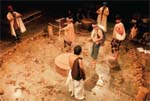 Al Deen’s Chaka gives artistic expression of reality
Al Deen’s Chaka gives artistic expression of reality
Found only in the theories, books and dictionaries, the ‘Welfare State’ does not exist in reality. This fact has been explored artistically in
Selim Al Deen’s play Chaka.
It’s not a political play or any rough theatre criticising the concept of a repressive state as done by many western playwrights.
In Chaka, the root searching dramatist Al Deen has touched the burning issue through the narratives of the common people and nature.
Correctly, in the concluding remark of the published book Chaka, the late playwright wrote that Chaka was not any symbolic play neither was his intention to present the reality.
‘But, if anybody interprets the play as an explanation of an occurrence, I’ll not disagree,’ the remark reads.
A poet by nature, Selim Al Deen wrote the katha natya, the term developed and used for the play by the theoretician and playwright in 1990, mourning the deaths of the innocents who had been killed by the law enforcing agencies during the anti-autocratic movement of the country in 1986-87.
It is really a challenge for the young director Sudip Chakrobarthy to present the very popular play for the contemporary audience as a production by the theatre department of Dhaka University since Chaka had already been staged by the leading troupes at home and abroad in Bangla, Hindi and English.
As a director, Sudip has remained very authentic to the text of the play and the traditional concept of narrative style where the narrators unfold a story to the audience.
But, special aspects of Sudip’s directorial composition remain in experimentation on creating frequent visual images onstage and in establishing the prominent characters through fixed actors.
Usually, in the conventional narrative presentations, the narrators enact the characters through transformation of gestures and movements.
Despite having three narrators in the play, Sudip has used four actors- Mahzabin Islam, Nusrat Sharmin, Sushanta Kumar Sarkar and Khan M Rafikul Islam- in the major characters of the katha natya production to tell a simple story: the tedious journey to carry the body of a ‘sarkari lash’ [a person killed by the government agency] that does not reach its destination.
All these skilled actors as cart pullers named Naher Garoan and his associates in their futile journey develop an emotional attachment with the unwanted body, even though they don’t find the right destination as everybody refuses to accept the body claiming the address and the name of the body Hossain Ali mentioned in blurred letters in the government note do not match.
Supported by the musicians, three energetic narrators- Mehedi Tanzir, Syeda Ifat Ara and Laboni Aktar- have successfully created different visuals of the imageries and myths created by Al Deen in the text where trees, bees and other natural elements mourn for the dead body.
But the use of some of these visuals sometimes appear meaningless and not well established, for instance, the display of traditional scroll painting and use of puppet theatre.
The use of some realistic props also appears too ornamented. Sudip as the director appeared monotonous by the end of the play, especially in case of employing a conch shell sound effect to announce the end of the play.
However, the use of circular performing space in the production successfully reflects the inherent message of the play: state as a repressive authority appears repeatedly and the concept of the welfare state, in which the state plays a key role in the protection and promotion of the economic and social well-being of its citizens, is just a far cry.
Chaka was produced by the theatre department of Dhaka University. It was premiered a day before Selim Al Deen’s 64th birth anniversary on August 17 at the National Theatre Hall of Bangladesh Shilpakala Academy.
The department also orgnaised a five-day staging of the play at the Natmandal at Dhaka University that ended on Tuesday.
-With New Age input




















